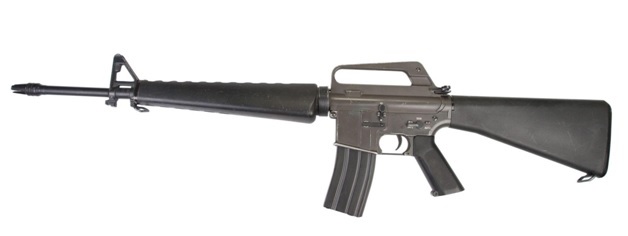AR-15 and M16: What’s the Difference?
Jun 6th 2023
Apparently, one of the most common inquiries on the web about AR-15 and M16 rifles is “what is the difference between an AR-15 and M16?”, or some variant of that question.
To be fair, the two rifles are very, very similar in appearance and operation. They were also both built around the same cartridge.
Even shooters that are well versed in arms and military history might look at one and mistake it for the other.
So, what is the difference between the AR-15 and M16, at least from a high level?
AR-15 vs. M16: History
What you might not know about the AR-15 and the M16 is the that former, which has come to be accepted as the civilian model, came first.
In the mid 1950’s the Army was working on a replacement rifle for the M14, one which was chambered in a lighter cartridge that preserved some of the ballistic performance of the .30-06 and 7.62x51mm NATO, around which the M1 Garand and M14, respectively, were developed.
The new cartridge was the 5.56x45mm NATO, and the rifle the AR-15.
The AR-15 was a gas-powered rifle which uses a gas-impingement system to operate the action, and is capable of selective fire.
Unfortunately, the design, which was created by Eugene Stoner for Armalite (which is where AR, or “Armalite Rifle” comes from), was sold to Colt in 1959.
As for the M16, it has the longest-standing record of commission as a service rifle, in the history of the United States.
First formally adopted in 1964, it was developed from the original designs for the AR-15 and numerous variants have been produced.
The M16 is also selective fire, and depending on the variant, is capable of either semi/full auto or semi auto/burst fire functionality.
The most recent variant developed, the M16A4, was completed in 1997 and changes the classic “carry handle configuration” of most M16 rifles, opting instead for a rail that enables the soldier to easily mount optics or other accessories.
But, even with these distinctions, this does not posit an answer to the question posed at the beginning of this article.
So, what are the differences between these two platforms?
AR-15 vs M16: Parts

The most obvious answer to the question “what is the difference between an AR-15 and M16 rifle?” is also grossly oversimplified.
Do a quick search or ask a friend that shoots or has been in the military. You’ll probably get an answer something like this “the AR-15 is semi-auto only and the M16 offers selective full-auto fire.”
That is not categorically incorrect but it does oversimplify the true answer.
To understand the difference, it’s best to say that an M16 is categorically an AR-15, but an AR-15 is not necessarily an M16. This is sort of like the saying, “all squares are rectangles but not all rectangles are squares.”
If you go back and look at early models, some of them are stamped as both “AR-15” and “M16” on the receiver. This is because between about 1964 and 1969, the name AR-15 applied to both variants.
Knowing this, then, the matter comes down to what was mentioned in the previous section - that is, M16 rifles are capable of fully-automatic fire and AR-15 rifles are not.
With respect to modern variants, that is certainly true. Modern civilian AR-15 rifles are not capable of fully-automatic fire, at least, not without illegal modifications.
This has to do with the key differences of select AR-15 and M16 parts, specifically, the lower receiver.
If you look at the lower receiver of both an AR-15 and M16 rifle side by side, removing the trigger and looking up into the trigger pocket, you will likely see the giveaway in the FCC (fire control channel).
In an AR-15 lower, a modern civilian version, that is, there will not be a third pin hole for the auto sear above the safety selector. Often, the AR-15 lower receiver is milled out according to different dimensions in order to prevent the insertion of the third pin for the auto sear, anyway.
However, some AR-15 rifles are produced with the same FCC dimensions as an M16, they just don’t have that third hole.
This brings up another interesting question, which is, then, are AR-15 and M16 parts interchangeable?
Again, there is no easy answer here, but the short answer (which is usually true) is, for the most part, yes.
If the two rifles are both chambered for 5.56x45mm NATO, then nearly all parts should be interchangeable between them.
The two main differences in terms of parts are the lower receiver and the auto sear. You cannot use the lower receiver of an M16 for an AR15 if the fire control channels do not correspond, and the AR-15 cannot accept an auto sear. Doing so would illegally convert it into a fully-automatic platform, like the M16.
Here for AR-15 or M16 Parts? We Have Them
If you’re here because you’re looking for AR-15 or M16 parts, we have them. We also carry build kits for AR-15 rifles, as well as parts kits. Check out our collection and if you have questions about compatibility or interchangeability, contact us at 610-250-3960.

